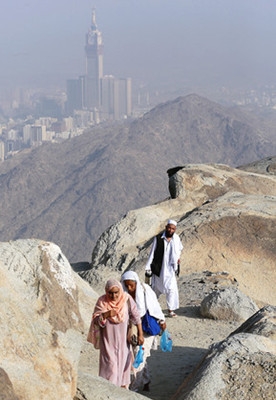Business
商業報道
Religious tourism
宗教旅游業
Pennies from heaven
來自天堂的便士
Pilgrimages are a big business—and getting bigger
朝拜活動內含巨大商機-而且前景持續變好
MECCANS say they do not need agriculture, for God has given them the pilgrimage as their annual crop.
這就是那條路,我相信麥加人說他們不需要農業,因為神已將朝圣之行當作他們一年的作物。
Millions of Muslims are now setting out to take part in this year's haj, a trek to Islam's holiest site, in Saudi Arabia.
幾百萬穆斯林現正開始了艱苦跋涉,去沙特阿拉伯的伊斯蘭圣地麥加朝圣。
 The haj, which all Muslims aspire to do at least once in their lifetimes, now brings in 16.5 billion, around 3% of Saudi GDP.
The haj, which all Muslims aspire to do at least once in their lifetimes, now brings in 16.5 billion, around 3% of Saudi GDP.
所有穆斯林們渴望在他們一生中至少實現一次的麥加朝圣占沙特的GDP約3%,也就是165億美元。
Jerusalem, a holy city for all three Abrahamic religions, also draws crowds of pilgrims, and huge numbers of Shia Muslims visit shrines in Iraq.
作為三個亞伯拉罕教圣地的耶路撒冷,也吸引了成群結隊的朝圣者,還有大量的什葉派穆斯林去參觀位于伊拉克的神龕。
The UN's World Tourism Organisation estimates that over 300m people go on pilgrimages each year. Countless others visit shrines or sacred places.
聯合國世界旅游組織分析每年有超過3億人進行超生活動。無數的游客直接參觀神龕和圣地。
The numbers are increasing because the Middle East's growing middle class means more tourists, three-quarters of whom travel within the region.
因中東中產階級不斷擴大而增加的人數意味著更多的游客,四分之三的游客是宗教式的旅行。
Abundant tumult is less likely to deter those travelling for religious reasons than ordinary tourists.
相對于普通游客,再多的騷亂也不太可能打消那些為了宗教原因去旅行游客的念頭。
Shia pilgrims still flock toKarbalaand Najaf inIraq, despite the threat of bombs.
什葉派朝圣者不顧炸彈的威脅仍聚集到伊拉克的卡爾巴拉和納賈夫。
The person who sees their holiday as a cultural experience will be put off by bad security, but the believer will not, says Kevin Wright, an observer of new tourist markets.
那些被危險嚇走的人只是把他們的假期看做一次文化體驗,而信仰者們不會信旅游市場觀察員Kevin Wright說。
Faith-based tourism in the region dates back to Moses leading his people through Sinai with God as their tour guide, jokes Peter Tarlow, a travel consultant who is also a rabbi.
宗教里以信念為基礎的旅行可追溯到摩西在上帝的指引下帶領他的人民通過西奈半島,猶太教律法專家顧問Peter Tarlow開玩笑說。
In medieval times Venetian traders took Europeans on trips to theHoly Land.Israelhas long promoted religious tourism.
在中世紀,威尼斯商人就把歐洲人帶到了前往圣地的路上。
Yet most countries have been slow to profit from their religious sites.
以色列早就發展了宗教旅游業。現在大多數國家慢慢開始在宗教景點上盈利。
One exception is the haj, which has both expanded and gone upmarket.
唯一的例外就是麥加朝圣,它既擴大了高端市場也流失了高端市場。
Oil wealth and a rising identification with Islam have made it a huge moneymaker.
石油財富和對伊斯蘭教的同情感的提升都使它成為巨大的賺錢機器。
Posh hotel chains have piled into Mecca, including Raffles, which in 2010 opened the spa-equipped Makkah Palace.
高檔酒店鏈已經充斥麥加,其中包括Raffles在2010年開了帶有溫泉浴場的Makkah Palace。
Souvenir shops do such a roaring trade that some only bother to open during the haj.
紀念品商店也大肆擴展了貿易,甚至游俠只在麥加朝圣時營業。
Travel firms in the tourists' home countries do nicely too.
旅行者家里的旅行電影也做得很精美。
InEgypt packages cost up to 80,000 Egyptian pounds, according to Reda Dunia, who runs a travel agency inCairo.
根據開羅旅行社Reda Dunia的數據,開羅旅游套餐價格高達80,000歐元。
Some pilgrims grumble about the rising cost of performing their religious duty. Airlines and hotels put up their prices during religious holidays.
一些朝圣者抱怨旅行宗教職責時花銷上漲。
Nevertheless, says Mr Dunia, Muslims often save for years for their haj, so most of them are willing to spend money on the experience.
航空公司和酒店在宗教節日時上漲他們的價格。而Dunia卻說,穆斯林們經常為了麥加朝圣而存幾年的錢,因此他們中大多數愿意在這體驗上花錢。
Some tour operators now offer packages that include leisure pursuits alongside the religion.
一些旅行社現在提供包括與宗教擦邊的閑暇旅游套餐。
This helps to boost the price tag and might also persuade agnostics and atheists to visit holy sites just for the cultural experience.
這就助漲了價格標簽,也可能會吸引一無所知的人和無神論者為了文化經歷去參觀圣地。
Countries lacking their own religious landmarks are now trying to create them.
缺少自己宗教標志的國家正在嘗試創造他們。
In June Dubai's authorities announced plans to build a Holy Koran theme park, with walls depicting stories from the Koran and a garden of plants mentioned in it.
六月,迪拜官方宣布計劃建立期可蘭經圣地主題公園,墻上描繪可蘭經里的故事和里面提到的花園里的植物。
Dubaiis betting that the pious are as profitable as the shoppers and fun-seekers that it currently attracts.
迪拜正豪賭著虔誠信徒們會像消費者和尋歡者們被它吸引的那樣為它盈利。











